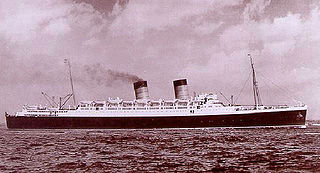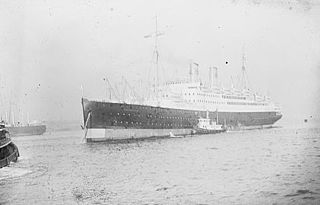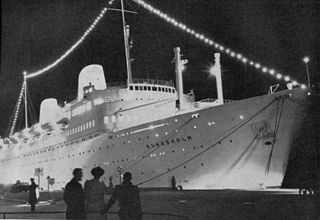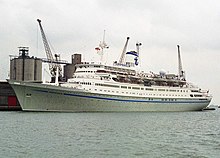
Queen Elizabeth 2 (QE2) is a retired British passenger ship converted into a floating hotel. Originally built for the Cunard Line, the ship was operated by Cunard as both a transatlantic liner and a cruise ship from 1969 to 2008. She was then laid up until converted and since 18 April 2018 has been operating as a floating hotel in Dubai.

An ocean liner is a type of passenger ship primarily used for transportation across seas or oceans. Ocean liners may also carry cargo or mail, and may sometimes be used for other purposes. The Queen Mary 2 is the only ocean liner still in service to this day.
MS Gripsholm may refer to one of these passenger ships:

RMS Caronia was a 34,183 gross register tons (GRT) passenger ship of the Cunard Line. Launched on 30 October 1947, she served with Cunard until 1967. She was nicknamed the "Green Goddess" after her light green hull livery. She was one of the first "dual-purpose" ships, built both for 2-class transatlantic crossings and all 1st-class cruising. After leaving Cunard she was briefly Caribia in 1969, after which she was laid up in New York until 1974, when she was sold for scrap. While being towed to Taiwan for scrapping, she was caught in a storm on 12 August. After her tow lines were cut, she repeatedly crashed on the rocky breakwater outside Apra Harbor, Guam and broke into three sections.

MS Marco Polo was a cruise ship originally built as ocean liner Aleksandr Pushkin in 1965 by Mathias-Thesen-Werft, East Germany for the Soviet Union's Baltic Shipping Company. After major alterations and additions, the ship operated as Marco Polo for the Orient Lines from 1993 to 2008. It last sailed for UK-based Cruise & Maritime Voyages and its German subsidiary Transocean Tours. After Cruise & Maritime Voyages entered administration in 2020 due to the COVID-19 pandemic, it was sold at auction by CW Kellock & Co. Ltd. for US$2,770,000 on 22 October 2020; it was subsequently resold and in January 2021 was beached at Alang, India and scrapped.

RMS Mauretania was a British ocean liner that was launched on 28 July 1938 at the Cammell Laird yard in Birkenhead, England, and was completed in May 1939. She was one of the first ships built for the newly formed Cunard-White Star company following the merger in April 1934 of the Cunard and White Star Line. On the withdrawal of the first Mauretania in 1935, to prevent a rival company using the name and to keep it available for the new liner, arrangements were made for the Red Funnel paddle steamer Queen to be renamed Mauretania in the interim.

RMS Adriatic was a British ocean liner of the White Star Line. She was the fourth of a quartet of ships of more than 20,000 GRT, dubbed The Big Four. The Adriatic was the only one of the four which was never the world's largest ship. However, she was the largest, the fastest, and the most luxurious of the Big Four, being the first ocean liner to have an indoor swimming pool and Victorian-style Turkish baths.

MS Vistafjord was an ocean liner that was built as a combined liner/cruise ship in 1973 by Swan Hunter, England for the Norwegian America Line. In 1983 she was sold to Cunard, retaining her original name until 1999 when she was renamed Caronia. In 2004 she was sold to Saga and sailed as Saga Ruby until sold in 2014 for use as a floating hotel and renamed Oasia. This never came to fruition. Her owners went bankrupt, and in April 2017 she arrived at Alang Ship Breaking Yard, India for scrapping.

MS Black Watch was a Royal Viking Star-class cruise ship. She was built by Wärtsilä Helsinki Shipyard, Finland for Royal Viking Line as Royal Viking Star, entering service in 1972 as the lines first ship. She has also sailed for Norwegian Cruise Lines as Westward and Royal Cruise Line as Star Odyssey. As of June 18, 2022 she has been beached for scrapping as Odin at Alang, India.

RMS Sylvania was an ocean liner built in 1957 by John Brown & Company, in Glasgow, Scotland for Cunard. She was the last Cunard vessel built specifically for transatlantic crossings. The ship was later heavily rebuilt as a cruise ship, and sailed under the names SS Fairwind, SS Sitmar Fairwind, SS Dawn Princess and SS Albatros before being scrapped in 2004. She was renamed SS Genoa for her last voyage.

MS Queen Elizabeth (QE) is a cruise ship of the Vista class operated by the Cunard Line. The design is modified compared to earlier ships of the same class, and slightly larger than Queen Victoria, at 92,000 GT. This is due to a more vertical stern, and additional cabins for single travelers. The bow of Queen Elizabeth and Queen Victoria are both reinforced having thicker than the standard for hull plating, to handle North Atlantic weather. The ship is able to carry up to 2,092 passengers.

MS Cunard Princess was a cruise ship, previously owned an operated by the Israel-based Mano Maritime. She was built 1975 by the Burmeister & Wain shipyard in Copenhagen, Denmark, for Cunard Line as MS Cunard Conquest, but her interior fittings were subsequently installed at the Navali Mechaniche Affini in La Spezia, Italy. Following re-delivery from Navali Mechaniche Affini in 1977 the ship was renamed MS Cunard Princess. In 1995, the ship entered service with StarLauro Cruises, briefly retaining her previous name before being renamed MS Rhapsody. In 2009 she was sold to Mano Maritime and sailed as Golden Iris until 2018, when she was laid up at Chalkis Shipyard, Greece. In 2021 she was renamed Gold Club. After four years lay-up, she was sold in 2022 to Turkish shipbreakers and beached at Aliağa for recycling.

MS Gripsholm was an ocean liner, built in 1924 by Armstrong Whitworth in Newcastle-upon-Tyne, England, for the Swedish American Line for use in the Gothenburg-New York City run. She was of great historical importance as the first ship built for transatlantic express service as a diesel-powered motor vessel, rather than as a steamship.

MV Kungsholm was built in 1964/5 by the John Brown & Company shipyard in Clydebank, Scotland as a combined ocean liner / cruise ship for the Swedish American Line. She was later rebuilt as a full-time cruise ship, sailing under the names Sea Princess, Victoria, Oceanic II and Mona Lisa. In September 2010 she was retired from service, as she did not fulfill requirements to SOLAS 2010, becoming the floating hotel Veronica, before being scrapped in 2016.

MS Kungsholm was a combined ocean liner / cruise ship built in 1953 by the De Schelde shipyard in Vlissingen, the Netherlands for the Swedish American Line. Between 1965 and 1981 she sailed for the North German Lloyd and their successor Hapag-Lloyd as MS Europa. From 1981 until 1984 she sailed for Costa Cruises as MS Columbus C. She sank in the port of Cadiz, Spain after ramming a breakwater on 29 July 1984. The vessel was refloated later that year, but sent to a Barcelona shipbreaker in 1985 for scrapping.

RMS Carinthia was an ocean liner built in 1956 as one of the four Saxonia-class ships. She sailed for Cunard Line from her completion until 1968 when she was sold to Sitmar Line, rebuilt into a full-time cruise ship and renamed SS Fairsea. She sailed with Sitmar until 1988, when Sitmar was sold to P&O. She was renamed SS Fair Princess and sailed for Princess Cruises and P&O Cruises until 2000. She was then sold to China Sea Cruises and renamed SS China Sea Discovery. In 2005 or 2006 she was scrapped at Alang, India.

MS Astor was a cruise ship that most recently sailed for Cruise & Maritime Voyages' Transocean Cruises subsidiary, under which she operated voyages to Europe, South Africa, and Australia.

RMS Queen Mary 2 (QM2) is a British ocean liner. She has served as the flagship of the Cunard Line since January 2004, and as of 2024, is the only active, purpose-built ocean liner still in service. Queen Mary 2 sails regular transatlantic crossings between Southampton and New York City, in addition to short cruises and an annual world voyage.
Saga Shipping, also known as Saga Cruises, a division of the Saga plc, is a cruise line headquartered in Folkestone, England. Saga Cruises exclusively markets to and operates for people aged 50 and over.

MS Saga Pearl II was a cruise ship of about 18,700 GT that was built in Germany by Howaldtswerke-Deutsche Werft as the Astor in 1981. After short unsuccessful operations with two owners, she was bought by the East German government in 1985 and renamed Arkona. After 1990 the ship was operated by Seetours, which was acquired by P&O Princess Cruises in 1999, and then chartered to Transocean Tours as Astoria in 2002. From 2009 until 2019 she was owned by Saga Cruises as Saga Pearl II, then withdrawn from service, laid up as Pearl II, and scrapped in 2022.






















